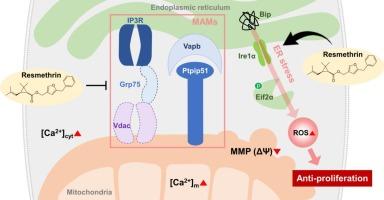氯氰菊酯破坏线粒体相关膜,激活内质网应激,导致培养的小鼠莱迪格细胞和肥大细胞增殖受抑制
IF 4.2
1区 农林科学
Q2 BIOCHEMISTRY & MOLECULAR BIOLOGY
引用次数: 0
摘要
甲氰菊酯是一种用于控制昆虫的拟除虫菊酯杀虫剂,对非目标生物和其他哺乳动物具有毒性。然而,人们对氯氰菊酯在睾丸中的生殖毒性及其毒性机制知之甚少。在这项研究中,我们研究了甲氰菊酯对小鼠睾丸的毒性,重点是线粒体和内质网(ER)。我们发现,氯菊酯抑制了 TM3 和 TM4 细胞的增殖和细胞周期进程,并破坏了线粒体膜电位(MMP;ΔΨ)。特别是,在这两种细胞系中,接触氯氰菊酯会显著降低线粒体相关膜(MAMs)蛋白的表达,如 Vapb、Vdac 和 Grp75。甲氰菊酯还能破坏线粒体基质和细胞质中的钙平衡。此外,氯氰菊酯还能激活氧化应激介导的ER应激信号。最后,我们证实ER应激抑制剂4-PBA能恢复TM3和TM4细胞的生长,而菊酯类除害剂会降低TM3和TM4细胞的生长。因此,我们证实氯氰菊酯阻碍了 MAMs 并激活了 ER 应激,从而抑制了 TM3 和 TM4 细胞的增殖。本文章由计算机程序翻译,如有差异,请以英文原文为准。

Resmethrin disrupts mitochondria-associated membranes and activates endoplasmic reticulum stress, leading to proliferation inhibition in cultured mouse Leydig and Sertoli cells
Resmethrin, a pyrethroid pesticide used to control insects, is toxic to non-target organisms and other mammals. However, little is known about the reproductive toxicity of resmethrin in the testes, or its mechanism of toxicity. In this study, we investigated the testicular toxicity of resmethrin on mouse Leydig (TM3) and Sertoli (TM4) cells, focusing on the mitochondria and endoplasmic reticulum (ER). We found that resmethrin inhibited proliferation and cell cycle progression and disrupted mitochondrial membrane potential (MMP; ΔΨ) in TM3 and TM4 cells. In particular, resmethrin exposure significantly reduced the expression of mitochondria-associated membranes (MAMs) proteins, such as Vapb, Vdac, and Grp75, in both cell lines. Resmethrin also disrupts calcium homeostasis in the mitochondrial matrix and cytoplasm. In addition, resmethrin activates oxidative stress-mediated ER stress signals. Finally, we confirmed that 4-PBA, an ER stress inhibitor, restored the growth of TM3 and TM4 cells, which was decreased by resmethrin. Therefore, we confirmed that resmethrin hampered MAMs and activated ER stress, thus suppressing TM3 and TM4 cell proliferation.
求助全文
通过发布文献求助,成功后即可免费获取论文全文。
去求助
来源期刊
CiteScore
7.00
自引率
8.50%
发文量
238
审稿时长
4.2 months
期刊介绍:
Pesticide Biochemistry and Physiology publishes original scientific articles pertaining to the mode of action of plant protection agents such as insecticides, fungicides, herbicides, and similar compounds, including nonlethal pest control agents, biosynthesis of pheromones, hormones, and plant resistance agents. Manuscripts may include a biochemical, physiological, or molecular study for an understanding of comparative toxicology or selective toxicity of both target and nontarget organisms. Particular interest will be given to studies on the molecular biology of pest control, toxicology, and pesticide resistance.
Research Areas Emphasized Include the Biochemistry and Physiology of:
• Comparative toxicity
• Mode of action
• Pathophysiology
• Plant growth regulators
• Resistance
• Other effects of pesticides on both parasites and hosts.

 求助内容:
求助内容: 应助结果提醒方式:
应助结果提醒方式:


